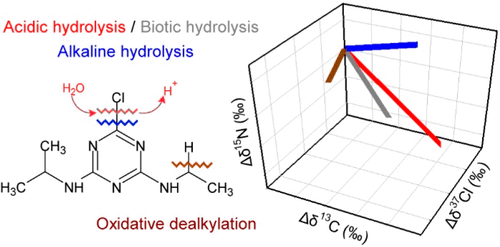当前位置:
X-MOL 学术
›
Environ. Sci. Technol.
›
论文详情
Our official English website, www.x-mol.net, welcomes your
feedback! (Note: you will need to create a separate account there.)
Triple-Element Compound-Specific Stable Isotope Analysis (3D-CSIA): Added Value of Cl Isotope Ratios to Assess Herbicide Degradation
Environmental Science & Technology ( IF 10.8 ) Pub Date : 2021-09-29 , DOI: 10.1021/acs.est.1c03981 Clara Torrentó 1 , Violaine Ponsin 1 , Christina Lihl 2 , Thomas B Hofstetter 3 , Nicole Baran 4 , Martin Elsner 2, 5 , Daniel Hunkeler 1
Environmental Science & Technology ( IF 10.8 ) Pub Date : 2021-09-29 , DOI: 10.1021/acs.est.1c03981 Clara Torrentó 1 , Violaine Ponsin 1 , Christina Lihl 2 , Thomas B Hofstetter 3 , Nicole Baran 4 , Martin Elsner 2, 5 , Daniel Hunkeler 1
Affiliation

|
Multielement isotope fractionation studies to assess pollutant transformation are well-established for point-source pollution but are only emerging for diffuse pollution by micropollutants like pesticides. Specifically, chlorine isotope fractionation is hardly explored but promising, because many pesticides contain only few chlorine atoms so that “undiluted” position-specific Cl isotope effects can be expected in compound-average data. This study explored combined Cl, N, and C isotope fractionation to sensitively detect biotic and abiotic transformation of the widespread herbicides and groundwater contaminants acetochlor, metolachlor, and atrazine. For chloroacetanilides, abiotic hydrolysis pathways studied under acidic, neutral, and alkaline conditions as well as biodegradation in two soils resulted in pronounced Cl isotope fractionation (εCl from −5.0 ± 2.3 to −6.5 ± 0.7‰). The characteristic dual C–Cl isotope fractionation patterns (ΛC–Cl from 0.39 ± 0.15 to 0.67 ± 0.08) reveal that Cl isotope analysis provides a robust indicator of chloroacetanilide degradation. For atrazine, distinct ΛC–Cl values were observed for abiotic hydrolysis (7.4 ± 1.9) compared to previous reports for biotic hydrolysis and oxidative dealkylation (1.7 ± 0.9 and 0.6 ± 0.1, respectively). The 3D isotope approach allowed differentiating transformations that would not be distinguishable based on C and N isotope data alone. This first data set on Cl isotope fractionation in chloroacetanilides, together with new data in atrazine degradation, highlights the potential of using compound-specific chlorine isotope analysis for studying in situ pesticide degradation.
中文翻译:

三元素化合物特定的稳定同位素分析 (3D-CSIA):Cl 同位素比率的附加值评估除草剂降解
用于评估污染物转化的多元素同位素分馏研究在点源污染方面已得到很好的证实,但仅在农药等微污染物的扩散污染中才出现。具体来说,氯同位素分馏很少被探索,但很有前景,因为许多农药只含有很少的氯原子,因此可以在化合物平均数据中预期“未稀释”的特定位置的氯同位素效应。本研究探索了 Cl、N 和 C 同位素分馏相结合的方法,以灵敏地检测广泛存在的除草剂和地下水污染物乙草胺、异丙甲草胺和莠去津的生物和非生物转化。对于氯乙酰苯胺,在酸性、中性和碱性条件下研究的非生物水解途径以及两种土壤中的生物降解导致显着的 Cl 同位素分馏(εCl从 -5.0 ± 2.3 到 -6.5 ± 0.7‰)。特征双 C-Cl 同位素分馏模式(Λ C-Cl从 0.39 ± 0.15 到 0.67 ± 0.08)表明 Cl 同位素分析提供了氯乙酰苯胺降解的可靠指标。对于莠去津,不同的 Λ C–Cl与之前关于生物水解和氧化脱烷基化的报告(分别为 1.7 ± 0.9 和 0.6 ± 0.1)相比,观察到非生物水解的值 (7.4 ± 1.9)。3D 同位素方法允许区分仅基于 C 和 N 同位素数据无法区分的变换。关于氯乙酰苯胺中氯同位素分馏的第一个数据集,连同阿特拉津降解的新数据,突出了使用化合物特异性氯同位素分析研究原位农药降解的潜力。
更新日期:2021-10-19
中文翻译:

三元素化合物特定的稳定同位素分析 (3D-CSIA):Cl 同位素比率的附加值评估除草剂降解
用于评估污染物转化的多元素同位素分馏研究在点源污染方面已得到很好的证实,但仅在农药等微污染物的扩散污染中才出现。具体来说,氯同位素分馏很少被探索,但很有前景,因为许多农药只含有很少的氯原子,因此可以在化合物平均数据中预期“未稀释”的特定位置的氯同位素效应。本研究探索了 Cl、N 和 C 同位素分馏相结合的方法,以灵敏地检测广泛存在的除草剂和地下水污染物乙草胺、异丙甲草胺和莠去津的生物和非生物转化。对于氯乙酰苯胺,在酸性、中性和碱性条件下研究的非生物水解途径以及两种土壤中的生物降解导致显着的 Cl 同位素分馏(εCl从 -5.0 ± 2.3 到 -6.5 ± 0.7‰)。特征双 C-Cl 同位素分馏模式(Λ C-Cl从 0.39 ± 0.15 到 0.67 ± 0.08)表明 Cl 同位素分析提供了氯乙酰苯胺降解的可靠指标。对于莠去津,不同的 Λ C–Cl与之前关于生物水解和氧化脱烷基化的报告(分别为 1.7 ± 0.9 和 0.6 ± 0.1)相比,观察到非生物水解的值 (7.4 ± 1.9)。3D 同位素方法允许区分仅基于 C 和 N 同位素数据无法区分的变换。关于氯乙酰苯胺中氯同位素分馏的第一个数据集,连同阿特拉津降解的新数据,突出了使用化合物特异性氯同位素分析研究原位农药降解的潜力。











































 京公网安备 11010802027423号
京公网安备 11010802027423号